After a week off to recharge the batteries, the Eye Test is back with a return of last seasons most popular post on social media. Yes, Sockwatch 2023 is here.
Last year we saw that over half of NRL players were wearing their socks at or below the mid calf level, with primarily younger players and outside backs leading the trend. Is that still the case in 2023?
Firstly, I’d like to give a big shout out to rljerseys on Instagram for tagging me in a wonderful post whilst I was on vacation talking about how sock heights had changed over the years. And gratefully they’d not only tagged me in this post, but used some of my charts AND attributed it correctly. Lovely stuff, if only more would be so courteous.
This post was a great reminder that I hadn’t conducted a sock height analysis this year, and with the clock ticking down on the 2023 National Rugby League regular season, it’s a great time to check in and see if anything has changed in 12 months.
Another ulterior motive for doing it this round is that THE Dolphins have the bye, which means I can do year on year comparisons without having to do this for another weekend to get the same 16 teams from Magic Round 2022, or compare one team with the Dolphins this year. Neither of which seems ideal so Round 21 was decided upon.
As I did last year, before penning this post revisited the rules of the game to see if there was anything about how a players socks should be worn. It doesn’t seem like anything has changed, the closest thing I could find was this in part (b) of Section 4. The Players and Players’ Equipment :
(b) A player’s normal gear shall consist of a numbered jersey of distinctive colour and/or pattern, a pair of shorts, socks of distinctive colour and/or pattern and studded boots or shoes.
This means there’s still no legislation about how a players socks should be worn. Up, down, mid, crew, ankle with compression or TruSox sewn into traditional socks. All legal as far as the rules of the game. Although many will still claim, as I mentioned my dad did when I was younger in last year’s post, that it’s against the spirit of the game and players should be penalised for not wearing them “correctly”, whatever that is.
The methodology for this sock height analysis hasn’t changed either. I’ve kept it simple like last season. For every player who stepped onto the field for Round 21, I noted how high their socks were at the moment they entered the field, all 272 of them.
That’s an important distinction because players socks will generally wander south as the game progresses and I wanted to capture their intentions not their final resting place. Again, as noted last season, Matt Frawley had his socks down in the dressing room before the game but ran out on to the field with them just below his knees. Sock height watching is not for those without an eye for detail.
These Players are then categorised with sock heights as “high”, for the traditionalists or “low” for anything else. I noted last year that I wanted to use three categories – Low/Mid/High – but the time required to determine the difference between “Low” and “Mid” wasn’t worth it considering I’m already incredibly time poor. For now it’s the same as last year where “High” for traditional sock height and “Low” for everything below the medial head of the gastrocnemius (calf) muscle.
This leaves me with 272 players with the heigh of their socks as they entered the game for Round 21, 2023. We’ll be comparing this with Magic Round (Round 10), 2022 where I catalogued 275 players’ sock heights. There’s a few less players (272) this year as no 18th man substitutes were used.
I had planned one slight change this season, which was a “Low (with Compression)” entry for players like Pat Carrigan or Luciano Leilua who try to mask their non traditional ways by wearing full length calf compression socks or sleeves. I was thinking we’d see a decent number of players sporting this look and it would be worth investigating.
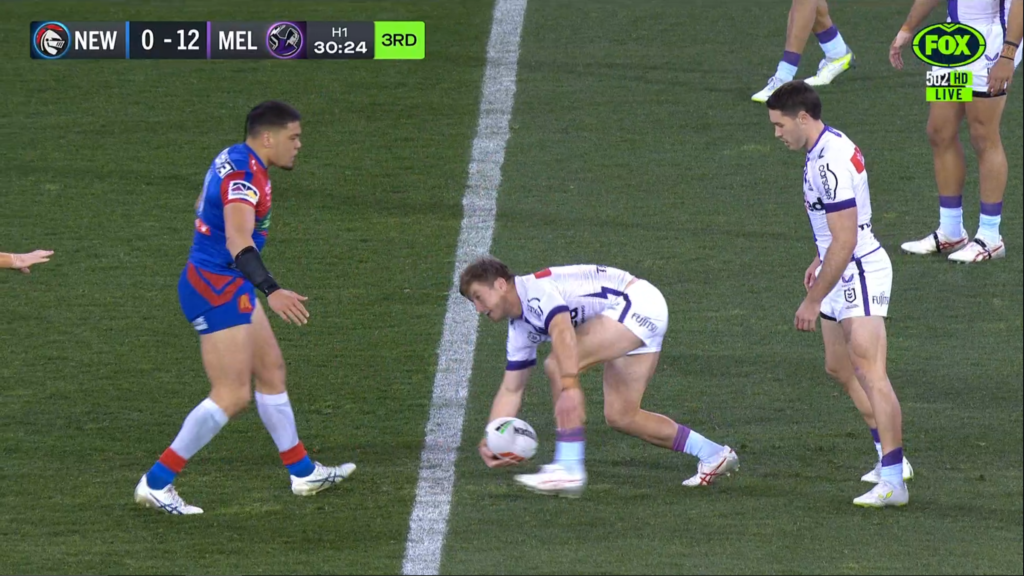
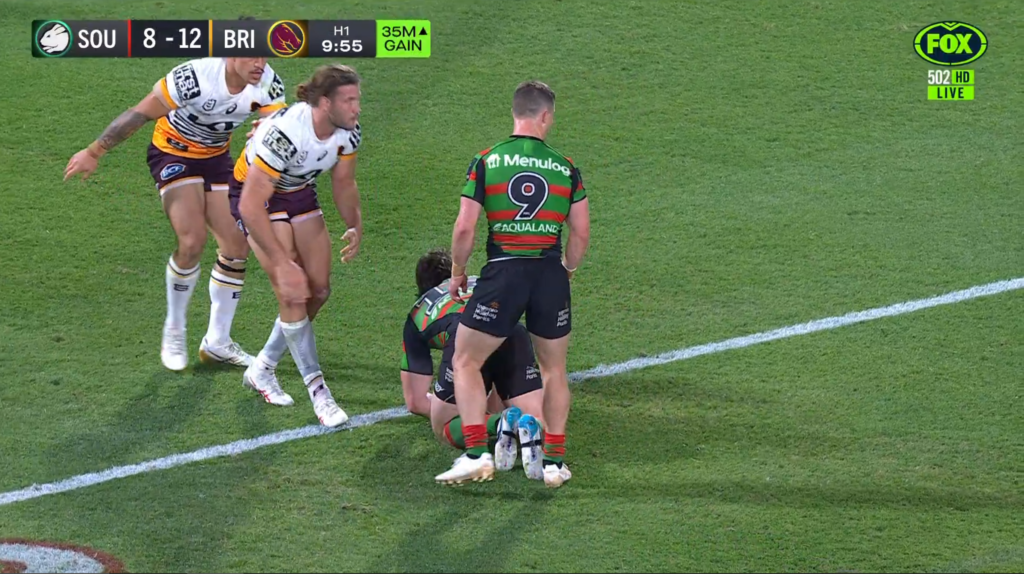
It turns out that there were only five players this round sporting this look – Carrigan (see above), Leilua, Jack De Belin, Leo Thompson (also above) and Aitasi James from the Wests Tigers. With such paltry numbers I won’t be splitting them as expected. I will note I did see Egan Butcher wearing high socks with compression sleeves underneath, but other than that the number of players wearing compression socks was far lower than I’d anticipated.
Another option if I had more time (LOL) I’d try to work out how many are sewing in TruSox feet to their normal socks but again that’s a time investment that returns very little reward. And the only outcome of it would be that any official sock sponsors for NRL teams would get upset as they have done overseas. If I was doing this gig full time instead of juggling it in the scant few hours between full time work and family then I’d be more inclined to push forward with that level of depth.
If only everyone was as obvious about it as Reece Walsh, then it might be a bit easier. At least it’s tider than Mitch Moses’ effort
Now the approach is clear, lets get onto the numbers.
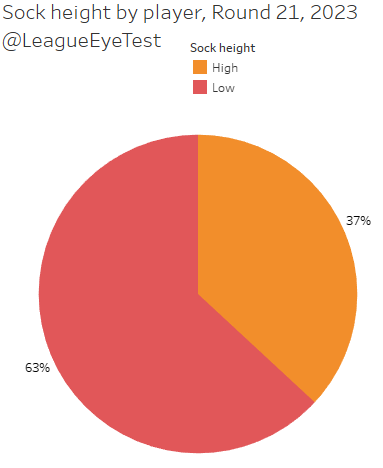
Lower sock heights are taking hold even further in the NRL this season, with 63% of players wearing socks at a height other than below the knee. That’s an increase of 6% on last year, where 57% of all players at Magic Round were wearing them low.
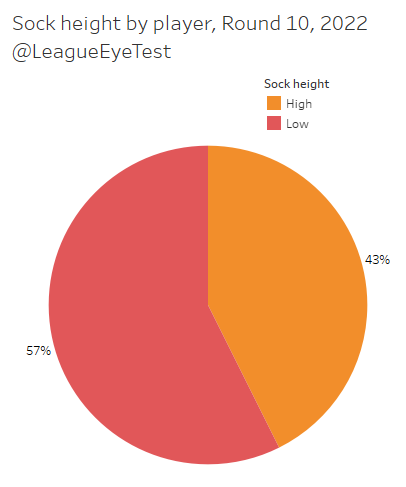
At this rate, by 2030 it could be a relic of the past like black boots or kicking duels.
Only two teams had more than half of their players wearing socks at knee height – Cronulla and North Queensland. The Sharks in particular are far more traditional than the rest of the NRL, with only 24% (or just four players) wearing lower height socks – Ronaldo Mulitano, Connor Tracey, Cameron McInnes and Thomas Hazleton.
The highest percentage of lower sock heights was Manly at 82%, with Canterbury not far behind at 76%. The Sea Eagles were the highest last year as well at 71%, but shared that with the Titans and Knights.
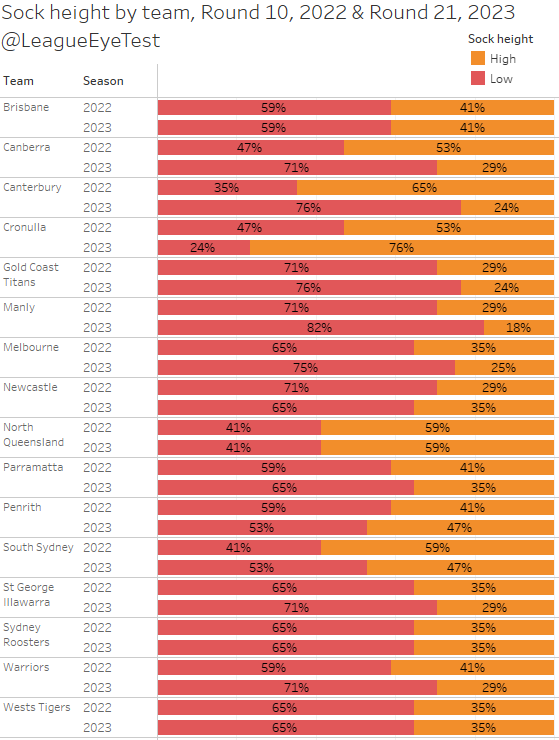
And last year we had four teams with more than 50% of players with knee high socks – North Queensland, Cronulla, Canterbury and South Sydney. That’s quite a swing for the Dogs, going from 35% low to 76% low in one season. And in a victory for the traditionalists, Cronulla actually increased their share of knee high socks.
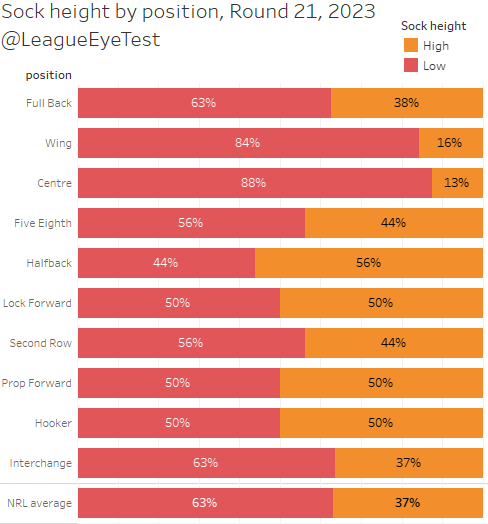
Unsurprisingly it’s the outside backs leading this trend, with both centres and wingers having more than 80% of players with low socks. Centres were at 88% and Wingers at 84%. The lowest number was for halfbacks, who at 44% were the only position where more players had high socks than low socks.
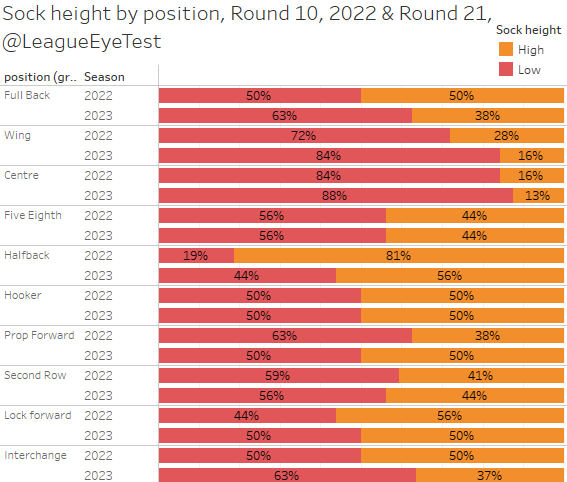
That said, the tide is turning as last year just 19% of halfbacks had low socks. Lock forwards were the only other position with fewer than 50% of players in knee high socks at 44%, with that number sitting at 50% now.
Even less surprising is that the low sock trend is being driven by younger players.
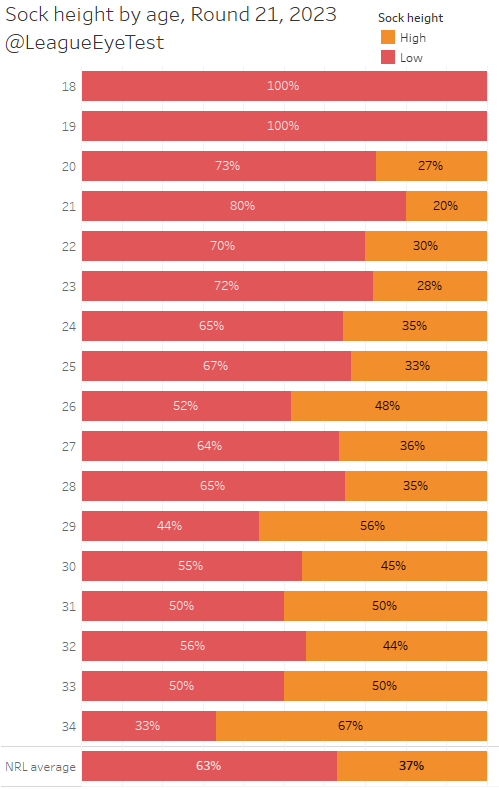
100% of players younger than 20 years old had low socks, but that’s a pool of just five players so it’s not significant enough. If you’re going to come into an article about sock heights and cry about sample sizes then you probably can’t enjoy anything in life.
Between 20-23 had no fewer than 70% of players with low socks, and outside of 26 year olds, every year up to 28 had at nearly two thirds of players with low socks.
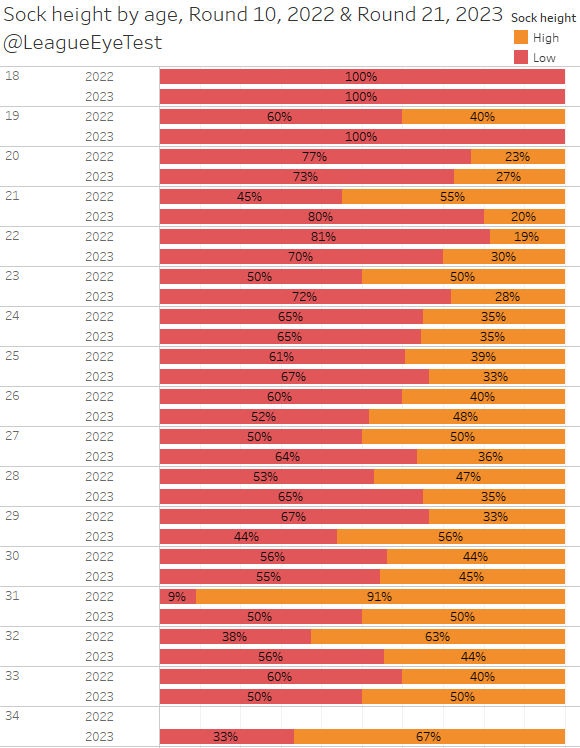
That’s a bit of a change from 2022, where both 21 and 23 year olds were in the 44% to 48% range. It’s very clear that low socks are in with the younger rugby league players.
Players who were aged 29 years this round were the only significant age group to have fewer than half of their players with low socks, with just 44% of them wearing them at or below the belly of the calf. 34 year olds had just 33%, but there were only three of them playing this round. Even the elder statesmen of the competition, those from 30-33 also had more than half of players with low socks.
It’s very clear that long socks haven’t got much of a future in rugby league. Traditionalists better enjoy it while it lasts.


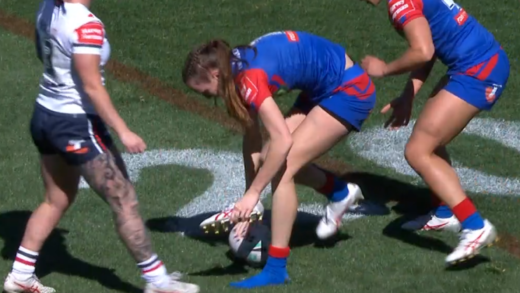
Socko post. Is there any correlation with efficiency? Are the low sockers sliding down the league table? Can your socks help you sock it to the opposition?